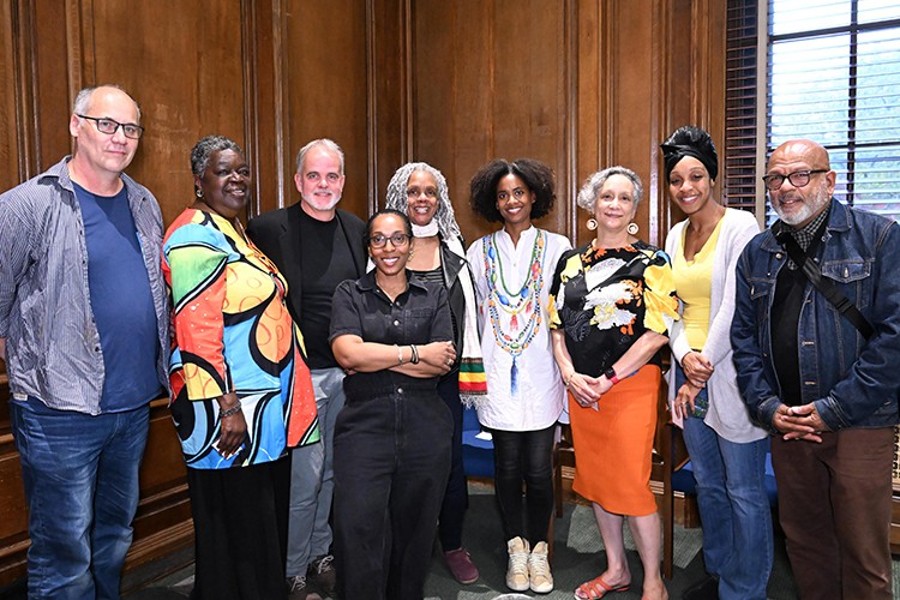Camille A. Brown and Dancers presented Mr. Tol E. RAncE at the Kitchen Tuesday, April 2 through Saturday, April 6. The work was inspired by Spike Lee’s controversial film Bamboozled and Mel Watkins’ book On The Real Side: Laughing, Lying, And Signifying – The Underground Tradition of African American Humor that Transformed American Culture, from Slavery to Chris Rock. This relatively concise dance theatre production was presented in two acts without an intermission.
Brown has expanded and embellished upon work, refining many of the theatrical elements from the last showing at the Joyce in 2012. Mr. Tol E. RAncE is clearly still evolving; a smart move on the part of Brown. Time is a valued commodity and in the arts where time is money and money is always an issue, it becomes a luxury. This latest incarnation has grown and has more depth and a greater use of subtext.
The work opened with a new video montage that resembled a movie credit role. Characters with the faces of iconic figures from black theater made their way across the cyclorama, to the accompaniment of pianist/composer Scott Patterson. The first impression is that this is a charming, touch in cheek opening, but in hindsight it casts the figures in a satirical light without humiliating the subject.
Scenes of minstrels in blackface, early tap dancers including Bill Bojangles Robinson, and comedians such as Stepin Fetchit followed. These images assisted in creating the setting for a more prolific statement. Patterson’s live accompaniment gave the footage a silent movie quality, which later carried over into the choreography.
The next two sections had a feeling of ordered pandemonium. Within the action Brown delineated primary action from secondary movement. At times a solo, duet and quartet happened simultaneously but we were able to discern the artistic intent and visual perceptive. Often the piano was used as a stage prop. Dancers leaned on it, rested underneath it, and placed legs on the lid and stretched.
The quick paced movements infused strong tap-like foot rhythms, vernacular and pedestrian movements with Brown’s own distinct style. The rhythms were often set in a call and response mode, with a dancer declaring a sound, and then an individual or group would affirm or respond the rhythm.
Brown also established foreground and background movement, a device that reoccurred throughout the work. She was able to accomplish this without the use of stagnant linear tableaus or frozen action sequences. This gave the work a multi-faceted texture that went beyond trite narrative theatrics and arbitrary cliché choreographic groupings.
The third section, which followed a video caption Ain’t we lucky… broke the non-stop movement juggernaut. The work started as a solo for Mora-Anina Parker she was joined by Juel D. Lane and Willie “Tre” Smith III. The movement had an adagio, sustained quality, oft times moving in deep plié with a rounded upper back and contracted midsections and a slow promenade with the feet in four-position en relevé.
Act II offered some of the works most provocative material. In a number of sections the dancers used spoken word to extract the desired response from the audience. The Dozens started out with “Yo mama” jokes between the dancers then quickly escalated into staged violence. In another section the cast recited in unison catch phrases from 70’s 80’s and 90’s sit-coms. “Dyno-Mite”, “What you talking about Wilson”, and the theme song from the Fresh Prince of Bel Air were a few of the slogans used. Out of context and their time period they all seemed dated and tinge with what could be seen as derogatory or demeaning imagery. The movement kept the dancers in a tight cluster creating both a sense of solidary and isolation.
Who You Be Nicca…That’s Me repeatedly used the “N” word to describe individuals in stereotypical situations. “Homeboys”, hypersexual women of color aka “hoes and bitches”, and well-endowed Mandingos, were among the stereotypes parodied. This originally had a game show feeling in the 2012 presentation with one narrator; now the solo diatribe had evolved into a dialogue performed by Brown and a chorus of dancers. The adjustment gave the section a more radical call and response irreverence.
The solo/duet performed by Waldean Nelson and his video image offered a fresh approach to a well-worn device. Nelson did not dance in tandem with the image. There were similar movements, which at time did create unison; but for the most part Brown created a subtle and interesting counterpoint between the physical performer and his image, which turned the dance into a true duet.
Again Brown relied on foreground and background action, this time she developed it into a dance for a lead dancer (Nelson), seven soloists and a corps of eight shadows cast against the cyclorama. As Brown moved to the front the focus shifted from Nelson to her and the physical “soloist” also moved into the background.
The work closed with a solo danced by Brown to a live piano rendition of What A Wonderful World. Originally this section featured a version with vocals by Louis Armstrong. This new interpretation provided Brown more freedom. The solo gave Brown an opportunity to share her strong sense of musicality, choreographer’s innate timing and phasing, and stage presence to create an indelible moment.
We commend Brown for her patience and fortitude. There was a time when artists developed works over several seasons; these dances were designed to stand the test of time. The works weren’t cookie cutter ballets with clever formulas, but works given the time to maturate. We look forward to Brown’s next evolution of Mr. Tol E. RAncE.
In Photo: 1) Camille A Brown 2) Willie “Tre” Smith III, Waldean Nelson, Juel D. Lane and Mayte Natalio 3) Camille A. Brown and Dancers 4) Waldean Nelson.
Become a Harlem Insider!
By submitting this form, you are consenting to receive marketing emails from: Harlem World Magazine, 2521 1/2 west 42nd street, Los Angeles, CA, 90008, https://www.harlemworldmagazine.com. You can revoke your consent to receive emails at any time by using the SafeUnsubscribe® link, found at the bottom of every email. Emails are serviced by Constant Contact









